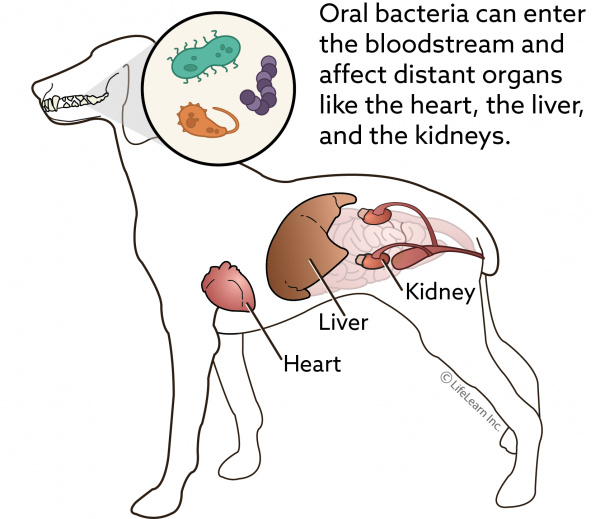When rough tartar accumulates on tooth surfaces and touches the gumline, it is time for a professional oral assessment, treatment, and prevention visit.
What is involved with a dental exam?
A dental exam is the first step to confirm that a dental cleaning is needed. Your veterinarian will review with you what procedures are likely required prior to the dental cleaning. Your veterinarian may perform preanesthetic blood tests to ensure that kidney and liver function are satisfactory for anesthesia, as well as an evaluation of the heart and abdomen if needed. Anesthesia is important to allow a tooth-by-tooth examination including dental x-rays.
What happens during a professional dental cleaning visit for my pet?
A dental cleaning visit will include a thorough dental examination, teeth cleaning, and polishing to remove the tartar and periodontal disease-causing plaque. This is done while your pet is under general anesthesia. Once anesthetized, your veterinarian, with the help of veterinary assistants, will thoroughly examine the mouth, noting abnormalities in the medical record. A dental probe will be used to evaluate gum bleeding and periodontal pockets where food can accumulate and decay if not properly cared for.
When periodontal disease is advanced, it may not be possible to save the badly affected teeth, which may need to be extracted either during the procedure or at a later time.
“For proper dental care, your pet will be placed under general anesthesia.”
The treatment your pet may require will be discussed with you after the cleaning once each tooth and the gums have been checked. Since it can be difficult to predict the extent of dental disease in advance of the procedure, your veterinarian may contact you during the procedure to discuss any additional treatment that may be necessary.
How are my pet’s teeth cleaned?
After a thorough examination of your pet’s mouth, tooth scaling will be performed, using both hand and ultrasonic scalers to remove plaque and tartar above and below the gumline. The tartar below the gumline causes the most significant periodontal disease, so it is important that it be thoroughly removed.
After scaling, the teeth are polished to remove microscopic scratches and decrease the rate of subsequent plaque build-up.
Click here to make an appointment!
Why can’t plaque and tartar be removed with a human dental scaler?
Although you can remove some of the accumulated plaque and tartar above the gumline in pets that are cooperative, there are four problems with doing this:
- Only the visible tartar above the gumline is removed. This leaves the plaque and tartar below the gum line which will continue to cause periodontal problems.
- It is neither possible nor safe to clean the inner surfaces of the teeth properly in a conscious pet.
- The use of any instrument on the tooth enamel will cause microscopic scratches on the surface which will ultimately damage the tooth surface, leading to further disease – this is the reason your dental hygienist always polishes your teeth after removing tartar with dental instruments.
- If your pet moves suddenly, the sharp instrument may cut the gums causing pain and bleeding.
Do I have to make an appointment for my pet to have a dental scaling and polishing?
Yes. Your veterinarian will perform preanesthetic tests and examine for underlying disorders prior to the procedure.
How can I prevent tartar accumulation after the procedure?
Plaque forms in as little as six hours after your pet’s dental cleaning. A home dental care program including regular tooth brushing is a must. Your veterinarian will provide you with detailed instructions on how to brush or rinse your pet’s teeth.
Can I use human toothpaste?
Absolutely not. Human dentifrice or toothpaste should never be used in pets. Human teeth cleaning detergents contain ingredients that are not intended to be swallowed and can cause internal problems if they are swallowed. Human products also commonly contain higher levels of salt which can be a problem for some pets.
You should also avoid using baking soda to clean your pet’s teeth. Baking soda has a high alkaline content and, if swallowed, can upset the acid balance in the stomach and digestive tract.
Why is pet toothpaste recommended?
Pet toothpastes are non-foaming, safe to be swallowed, and are available in flavors that are appealing to pets including poultry, beef, malt, and mint. If you use a product that tastes good, your pet will be more likely to enjoy the whole experience.
In addition to the pleasant taste, many of these toothpastes contain enzymes that are designed to help break down plaque chemically, which reduces the time you need to actually spend brushing your pet’s teeth.
What is dental disease?
Dental disease, also known as periodontal disease, is a condition in which the tissues supporting the teeth become inflamed. In its most mild form, periodontal disease is associated with gingivitis, or inflammation of the gums. In more severe cases, periodontal disease may manifest as tooth root abscesses, bone infection of the jaw, or as a pathologic (disease-induced) fracture of the jaw.
Can dental disease cause systemic disease?
When a pet develops dental disease, significant quantities of bacteria reside within the mouth and the oral tissues. These bacteria can enter the bloodstream and travel to other areas within the body, causing distant or systemic effects. There are three organs that are especially susceptible to the spread of oral bacteria: the heart, the liver, and the kidneys.

“There are three organs that are especially susceptible to the spread of oral bacteria: the heart, the liver, and the kidneys.”
The bacteria that are found within the mouth of pets with dental disease are the same bacteria that are often implicated in heart disease. These bacteria are associated with both endocarditis (inflammation/infection of the interior of the heart) and valvular disease in dogs and cats. Additionally, the presence of periodontal disease has been linked to an increased risk of heart disease in dogs.
The liver and kidneys are especially susceptible to the effects of dental disease. Both organs function primarily to filter the blood, which allows bacteria from the oral cavity to easily spread to each of these organs. Infection and inflammation within the liver and kidneys can cause signs of systemic infection (such as fever, weight loss, and decreased appetite), while also interfering with the function of these organs.
How are pets screened for systemic disease?
Your veterinarian uses a number of tools to screen for dental disease.
The first of these tools is the physical examination. In many cases, systemic disease has effects on the body that can be detected on a physical examination. A pet with heart disease may have a detectable murmur that can be auscultated (heard) with a stethoscope. A pet with liver or kidney disease may have visible weight loss or pain on palpation of the abdomen.
Next, your veterinarian will likely perform screening blood tests, including a complete blood count (CBC) and serum biochemistry. These tests assess a number of different liver and kidney function markers; elevations in these values may suggest the presence of liver or kidney disease.
If the results of the physical examination and blood tests suggest the presence of underlying disease, your veterinarian may recommend additional diagnostic tests. If your pet has signs of heart disease, for example, your veterinarian may perform chest x-rays to look for heart enlargement and signs of heart failure. If your pet has signs of liver or kidney disease, your veterinarian may recommend additional blood or urine testing.
Can the systemic effects of dental disease be minimized?
The best way to minimize the systemic damage associated with dental disease is to proactively prevent and treat dental disease. Dental conditions should be addressed as early as possible to minimize the risk of worsening and spreading. There are two components to dental care: home care and veterinary dental care.
Home care consists of brushing your pet’s teeth daily if possible. If you are unable to perform daily brushing, your veterinarian can provide alternatives such as an oral rinse or medicated dental chews.
Veterinary dental care, also referred to as a comprehensive oral health assessment and treatment, is performed under general anesthesia. Your pet will be anesthetized, using a combination of injectable and inhalant anesthetics. First, the tartar will be scaled off your pet’s teeth. Dental radiography (x-rays) will also be performed to evaluate the tooth roots and other tissues below the gumline. Once your pet’s teeth are clean and visible, your veterinarian will perform a thorough oral exam. Finally, your veterinarian will devise a treatment plan for any dental issues that have been discovered. These treatments may include extractions or more advanced dental procedures, such as a root canal.
“If your pet is experiencing systemic signs associated with dental disease, antibiotics may also be recommended.”
If your pet is experiencing systemic signs associated with dental disease, antibiotics may also be recommended. These antibiotics will minimize the quantity of bacteria in your pet’s mouth and bloodstream. It is important to note however, that antibiotics alone are not sufficient to treat dental disease or its systemic effects. Antibiotics are intended only as an adjunct to more definitive treatment.
Does systemic disease make anesthesia risky for my pet?
Although attempts to address dental disease are made as early as possible, situations sometimes arise in which a pet’s systemic disease increases the risk associated with anesthesia. After performing a thorough physical exam and pre-anesthetic bloodwork, your veterinarian may determine that your pet has a heightened anesthetic risk and needs additional diagnostics prior to anesthesia.
Rarely, you and your veterinarian may determine that the benefits associated with a dental procedure do not outweigh the anesthetic risks. In this case, your veterinarian will work with you to create a palliative care plan that minimizes the pain and infection associated with dental disease, while maintaining your pet’s quality of life for as long as possible. This approach is reserved only for pets with severe systemic disease, because it means that the dental disease will not be corrected and will continue to cause issues for the remainder of the pet’s life. It is always best to definitively treat dental disease when possible.
© Copyright 2019 & 2020 LifeLearn Inc. Used and/or modified with permission under license.






